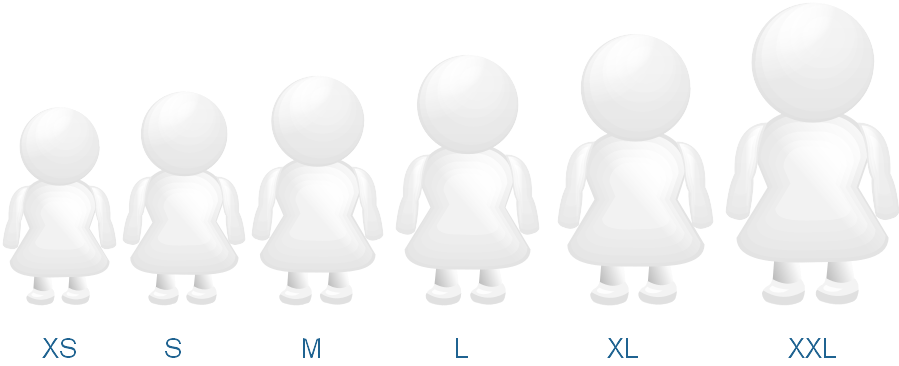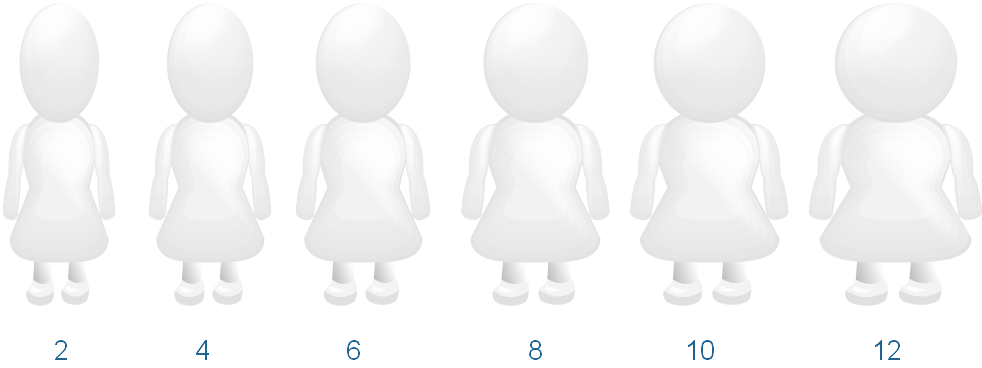Why Custom Made is Better for Tznius
Is standard size charts good for Tznius? Do every woman and girl fit into a standard size chart? Let me share with you more about standard size charts.
Why Don’t I Fit in a Size Chart?
There are basically two types of standard size charts. One that is based on scaling and one that is based on height.

Scaled Size Chart
The scaled size chart assumes that each size increment leads to a growth in height and other body proportions. For practical usage, a woman who gains a little bit of weight normally does not also gain in height, unless she’s a growing teenager. Unfortunately for her, she wouldn’t be able to purchase one size larger than before because the larger size will not fit her in terms of sleeve length and garment length.

Height Size Chart
The size chart that is based on height assumes a growth of body proportions mostly width wise and a small variation length wise. You may find some manufacturers offer a size chart based on average height, petite and tall. You would need to inquire the exact height that is used to define average, petite and tall. You may find an average definition to be 5 foot 5.5 inches and a petite definition to be 5 foot 2.5 inches. Again, these definitions vary from one manufacturer to the next. Unless you adhere to the height definition (+/- 0.5 inch) for these type of size charts, you may not be able to “fit in.”
The body proportions for a size chart are determined based upon a single profile. For example, a profile for size 8 may be chosen with average data collected from body measurement surveys. Or, the profile data may be entirely artificial based on a “perfect” woman. The accuracy of the artificial size 8 cannot be relied upon. From there, every other size bigger and smaller is determined through scaling.
Should I Wear Custom Made Clothing?
Tznius is a personal thing. Every body structure is unique. Two people with the same height do not share the same body proportions. This is true even of twins. A garment that is modest on one woman may not be modest on another of the same height.
The items that are important to tznius include the neckline, the fit of the garment, the length of the garment (hem line and sleeve length), the style of the garment and the color of the garment. It only makes sense that one should wear a custom-made garment that would guarantee the kashrus of the five items.
Neckline
The halachic parameters for a kosher neckline include covering the back first vertebrae bone (technically called the C7) and the front collarbone. None of the shoulder can be exposed. The measurement for a neckline is never ever revealed in a standard size chart. Why is this so? It is because the size chart measurement used for a neckline is artificial. Hence, one cannot rely on a standard size chart when buying clothes. A solution to this is to wear a dickey that is custom made to fix the immodest neckline of a garment. Read this article on how to accurately measure your natural neckline.
Length
The desired sleeve length has to extend beyond the elbow and a kosher skirt length has to be at a minimum, four inches below the knee cap. A blouse hem line has to be long enough so that the midriff is not exposed when one lifts up her hand. A skirt waistline has to be at the natural waistline in order to provide appropriate coverage.
Skirt lengths that are appropriate for tznius have become a challenge in our generation. At the time of writing, skirt lengths that barely cover the knees have become the norm. However, making a tznius skirt is actually a very easy thing to do. Here is a tutorial that shows you how.
Fit
A kosher garment must not be form-fitting on the entire body including the upper arm. An ample amount of ease has to be included in the design and construction of a kosher garment, using the proper fabric that does not cling to the body. In the dressmaking industry, garments are grouped into these wearing allowances: tight-fitting (no ease), close-fitting (less than 2 7/8 inches at the chest), form-fitting ( between 3 and 4-inches of ease at the chest), semi-fitting ( between 4 and 5 inches of chest ease), and loose fitting (between 5 and 8 inches of chest ease), and very loose fitting (more than 8 inches of chest ease). See this article to learn more about garment fitting.
Style
The style of clothing for a Bas Yisrael has to be refined in order to distinguish her from the nations around her. There are classic styles of clothing that always project a sense of dignity to the wearer and there are those styles which are dictated by fashion at a whim. Classic styles do not compromise on the femininity of the wearer and these are recommended over fashionable items.
Even if the fit of the garment is kosher, something else about it may not be kosher. In this generation, the fashion industry has decided to focus on loud styles using loud fabrics and colors. There are so many choices of fabrics out there that are wholesome and whose prints are graceful and refined. B’ezras Hashem, an article about refined styles will be made available in the near future.
Color
The color of a garment is also important for tznius. Colors come in many shades. Our Rabbis have determined that color of bright red is forbidden. A darker shade of red such as burgundy, maroon and wine is not forbidden. In addition, bright colors that fall in the neon color spectrum are also forbidden because they really catch the attention of the eye. Colors that come in a lighter shade or darker shades are not forbidden. This would include the pastels and earthy tone colors.
An interesting article about forbidden colors can be found here.
When making custom clothing, one can pick the appropriate fabric and determine the appropriate fit and length that is truly tznius for her. Isn’t it about time one seriously consider wearing custom-made clothing? Check out ModestAnytime.com and KosherPatterns.com for ideas and inspiration.
